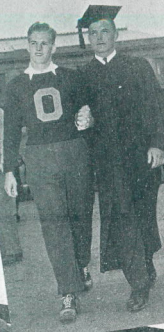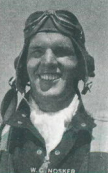By the time the 1940 football season came around, William “Bill” Nosker was one of the most experienced members of the Ohio State football team. He was a regular starter at guard on the 1938 and ‘39 teams, the latter of which won the school’s first outright Big Ten title since Nosker was 1 year old.
He contributed to an OSU team that went 4-4 in 1940, but shortly after the season ended, he would no longer be a student. During his senior year, he decided to enlist in the Air Force, for reasons he held close to his heart.
At that time, nobody knew him better than his then-future wife, Jean Sanborn. She’s now Jean Lombard, a 96-year-old resident of Upper Arlington, who met Nosker when they were both growing up in Upper Arlington.
Lombard said they started dating in high school, and they eventually married on Jan. 16, 1942, at Kelly Field in San Antonio, Texas. Before all of that happened, though, she has clear recollections of why Nosker enlisted even before America’s involvement in World War II began.
“He just loved to fly. He was so anxious to fly, that was all,” Lombard said. “But he left Ohio State a quarter before he was to graduate, and then, later on, wrote some kind of a term paper for his professor (to finish his degree).”
He wasn’t alone in joining, either. Fellow football stars Don Scott — an All-American, and the namesake of OSU’s airport, Don Scott Field — and Eino Sarkkinen all enlisted at the same time. They were given a send-off by the Varsity “O,” and joined four other OSU athletes in enlisting on March 16, 1941.
By August 1944, Nosker had flown about 35 missions, according to The Ohio State University Monthly, and he was awarded the Distinguished Flying Cross, the Bronze Star and the Air Medal. Like in his football playing days at OSU, Nosker was injured multiple times while in the service. One instance occurred in a softball game when Nosker slipped and hit a rock. Nosker’s first baseman on the same team: Lloyd Bentsen, the future U.S. Senator, Secretary of the Treasury and vice presidential candidate of “You’re no Jack Kennedy” fame.
Also playing in some of those games was Sgt. John “Doc” Allen, a medic in the 449th Bombardment Group of the 15th Air Force — the same as Nosker. The two were both Ohio natives, but in the summer of 1944, Nosker — now a major — was promoted to the 376th bomb group.
On the morning of Aug. 15 — a little over a month after his promotion — Nosker took off from a base in southern Italy as a part of the launch of Operation Dragoon. Nosker’s B-24 crashed soon after takeoff, and Allen just so happened to be nearby. The sergeant was one of the medics sent into the aftermath.
“They were trying to get the 449th bomb group behind his new group … and his plane crashed, (while) trying to get all the planes together. He crashed with the bombs, and all the ammunition and all the fuels and everything, and it was a terrible thing,” Allen said.
“In the process of gathering up the bodies, the remains you might say, our group was given the job of trying to determine the identity of these remains,” Allen said. “And the remains of one was an arm and a ring, with an (Ohio State Big Ten Championship) ring. And I asked the captain, I said, ‘Say, I know who this is. This is Bill Nosker.’ And he said ‘Take that ring off.’”
And he did. Allen said the situation — with flames and immense wreckage all around — was tough to negotiate. Without the ring, he doesn’t think he could’ve identified the body.
“No. No, there were several arms in there,” he said when asked.
Out of all the enlisted men, the one to find Nosker was someone who already knew so much about him as a fellow Ohio native and an OSU football fan. And Nosker’s body — once the makings of an accomplished offensive lineman — was no more. The last part of him that bore his identity was seen by someone who was able to recognize its significance right away.
And in that instant, the two men were forever connected.
———————
When you walk into the lobby of Nosker House, a residence hall on North Campus, there’s nothing really out of the norm. Relatively new tables and chairs, a pool table, a TV at one end. But turn to the left once you’re through the front door and there it is. A plaque with three pictures: one of Nosker in full football gear charging at the camera, another of him in his football jersey but standing in front of a plane and a final headshot of him in military uniform.
As the university began to expand north in the 1960s, the Board of Trustees decided to name the new low-rise residence halls after “former students who are representative of the University’s honored war dead,” according to its minutes. Nosker was chosen as one of them. Now, that area of campus is changing, and because of a $370 million redevelopment project on North Campus, Nosker House will feel the blow of a wrecking ball next spring.
Student Life spokesman Dave Isaacs said in an email that the university is “looking into options” regarding how it could commemorate Nosker and others in the new North Campus Residential District. Since all building names require approval from the Board of Trustees, Isaacs said OSU won’t have any new information on the subject until the Board meets in January, at the earliest.
There are, after all, people who care — “I hope they keep that name,” Allen said.
———————
The war in Europe lasted almost nine more gruesome months after Nosker died. Allen was one of those to survive it all, and while he was home on furlough, Hiroshima and Nagasaki were bombed. It was the end of that chapter in his life.
Nosker, meanwhile, was mourned immediately, a reflection of the impression he left. His good friend Scott had died a year before Nosker, and both were mentioned in numerous posts in The Lantern and The Monthly. The former put out a special “V-E Edition,” and the magazine’s editor John B. Fullen wrote of various former students who went to war. His description of Nosker:
“There was Bill Nosker. His buddies in Upper Arlington thought he was good enough to make the football varsity at Ohio State. He did. He was as handsome and strapping a young Viking as you ever saw. A few short years ago, we published Bill’s picture on the cover of The Monthly, walking ‘cross campus with a co-ed. Of all the fine pictures of college kids we have published, this was the classic. It radiated the good looks and youth and vitality, the glory and the strength of young America. You should have seen Bill in his military uniform as commander of a B-24 squadron. Usually a uniform does something for the wearer. Bill did something for the uniform.
“Bill walked into the office one day on leave from his squadron. So big and handsome he was with that open, boyish grin of his. The strong, friendly grip of his big paw almost broke our hand. When the word came that he had been killed in a bomber crash—a night flight for which he had volunteered—we could not believe it.”
Lombard still has numerous newspaper clippings and mementos of Nosker, and can still remember most, if not all, of his accomplishments, all these years later.
“I just never dreamed he wouldn’t come back,” she said. “Bill was pretty special.”
After the war, life went on for Allen.
Around the same time that issue of The Monthly was released, Allen used the G.I. Bill to go to college. But instead of going to med school like he had planned, he wound up attending OSU’s College of Veterinary Medicine and graduated in 1949. Once he got his degree, he was asked by the acting dean where he’d like to go.
“Well, I said, I’d like to go to Southern Ohio and he (the dean) said ‘that’s where we need (veterinarians). That’s a good idea.’ And I said well my dad played baseball down there in the town and got acquainted with them and I’d like to go to Waverly, Ohio,” Allen said.
He stayed, and married a woman named June on Dec. 8, 1945, and had three kids. They still live in the same house they moved into after Allen graduated from OSU. Allen was a veterinarian for 48 years, and served as Pike County Commissioner for 20 years — two full-time jobs, day and night. Now, at 91, he has time for other things, like watching his beloved Buckeyes, or spending time with fellow servicemen. This past August, the 449th reunited at Wright-Patterson Air Force Base outside of Dayton.
“The joke is: wherever you go, it doesn’t matter where it is, someone knows Doc,’” his son-in-law, Alan Davis, said. “So we’re at Niagara Falls, Canadian side. People everywhere. ‘Where’s Doc? Where’s Doc? Why hasn’t he kept up with us?’ Oh, he’s talking to someone he knows.”
And when Allen goes to shake hands, he directs the person away from his right arm. There’s a reason.
“Shake my left hand. It’s the one closer to the heart,” he said.
A heart that, like a ring, connected — and still connects — these two extraordinary men. Buckeyes by birth and education, known to peers unlike anyone else. The firm friendship of Bill Nosker and Doc Allen.
This story is part two of a two-part series about Maj. William Nosker and the man who identified his remains, Sgt. John Allen. Part one ran in Monday’s paper.

















